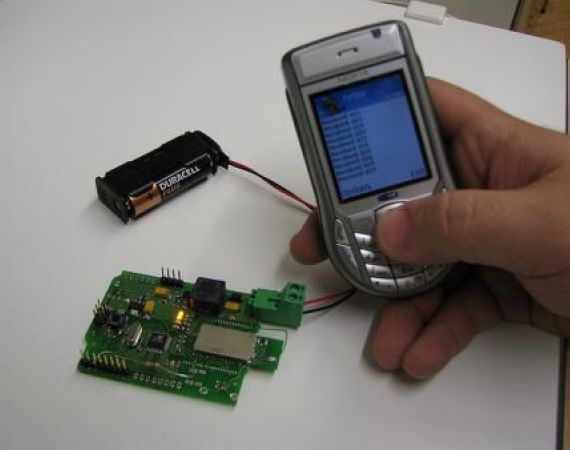Posted on Thu 18 Nov 2010
Introducing When Machines Talk

Image by David Mellis
Hello, I'm Dan, the Creative Technology Research Associate at the studio. I help our residents and others in the community with implementing the technology aspects of their work. I also keep an eye out for any technologies that have become recently possible, easy or interesting. Which is why I'm starting this little research project looking into what we can do with mobile phones beyond apps.
Mobile phones are the most widespread of pervasive technologies. There are more mobile phones than people in the UK and this will only increase as they're increasingly being embedded into other non-phone devices like the iPad, Kindle or Chip & Pin readers. But what can we do to push the limits of what's possible with the mobile phone?
Residents in the studio are creating more projects involving physical computing, such as our last group of artists in residence. Hazel Grian's Daemon is a social companion robot powered by a combination of an arduino and laptops. Mercurial Wrestler's Magicians Desk is a theatrical experience controlled by a hidden laptop and phidgets. Both arduino and phidgets have been fantastic tools for building projects like this. They both allow reading sensors and controlling outputs, letting us interface the physical with the digital. Typically they're paired with a computer in order to let us play audio and video or connect with the internet. The downside however is that laptops are large, have limited battery life, lack many built in sensors and depend on the venue having reliable wifi. A mobile phone would address these problems but is it an appropriate solution?
Mobile phones are following similar trends to that which PCs did decade before. PCs reached a threshold in cost, power and ease of programming, becoming a sufficiently powerful platform for building products on. Instead of buying a typewriter you would use word processor. Instead of getting Britannica there was Encarta. They weren't necessarily better than previous solutions but enabled a good enough solution for a cheaper cost than dedicated solutions.
Now the same is happening with phones, especially with iPhone apps. Books and magazines are replaced with eBook apps. Previous hardware product prototypes, like Buttons, were built as standalone physical devices. Now the are being sold as apps instead. The Dopplr travel display was prototyped on an iPhone screen rather than being built on arduino.
But by turning everything into an app on a screen we lose the tangibility of previous products. There are plenty of products trying to counter this trend. Products such as the birdbox alarm clock, iPad typewriter or vintage bluetooth handsets provide a nice way of augmenting the physical phone interface. I'll take a closer look at these and other existing projects in a future blog post.
There are very few examples however of using a mobile phone as the controller in physical computing, in the way we would use a laptop in the likes of the Magicians Desk. Those that do exists are usually robots made for fun. It is this controlling smart object with mobile phones that I intend to explore in greater depth.
Making Machines Talk aims to answer the question "Can we create physical computing projects using a mobile phone?". Hopefully we will discover when using a mobile is an appropriate and better solution than existing approaches, what it's limitations are and what new capabilities it gives us.
I'll be writing about the project as it goes along, sharing any useful discoveries or dead ends I find.